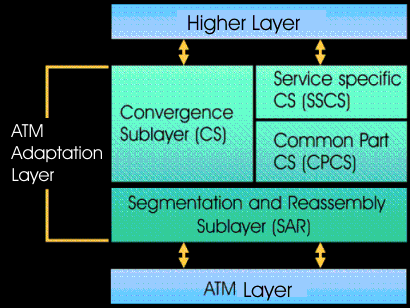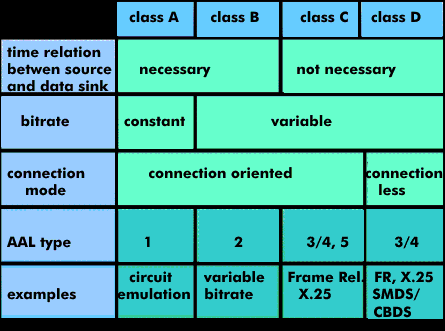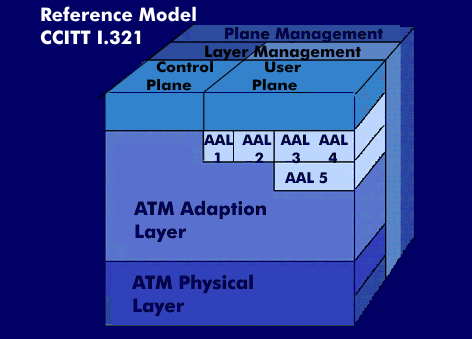ATM adaption layer (AAL)
The ATM Adaption Layer( AAL) adapts the low- level transport services for the required quality of service of the classes of application services above. In addition, the AAL layer provides the associated control and management functions.
To better define the diverse functions of this layer, the AAL layer is structured into two sub-layers: The Segmentation and Reassembly Sublayer( SAR) and the Convergence Sublayer( CS). The latter is in turn subdivided into the Service Specific CS( SSCS) and the Common Part Convergence Sublayer( CPCS).
The ATM Services
The different requirements for the various transmission services are defined by four AAL service classes, which are distinguished from each other by the time relation between source and destination, constant and variable bit rate, and connection type. The four classes are identified by the letters A, B, C, and D.
A class A service has a time relation, a constant bit rate, and is connection oriented. This class of service would allow emulation of a constant bit rate virtual circuit, for example, for the transmission of audio and video information for video conferencing.
Class B service has a variable bit rate. Classes A and B allow isochronous transmissions. Class C does not enable time relation, but has a variable bit rate and is connection oriented. This class is suitable for implementing classical connection-oriented anisochronous data transmissions. In contrast, class D operates connectionless and only transmits individual data packets without cohesion over a virtual link.
The AAL types and their properties
Five AAL types have been defined for the four different classes of service: AAL type 1 for class A, AAL type 2 for class B, AAL types 3 and 5 for class C, and AAL type 4 for class D
AAL type 1 supports constant bit rate( CBR) services such as voice and video. This allows all legacy services of this type, e.g. the entire previous plesiochronous hierarchy, to be mapped to B-ISDN. If necessary, the AAL-1 can also pass on to the receiver information on synchronization and the structure of the transmitted data
AAL type 2 is defined for variable bit rates( VBR) and transmits clock synchronously. AAL-2 supports services that do not require a fixed time reference between sender and receiver. Typical applications are variable picture and sound coding.
AAL type 3 is for connection-oriented transmission of VBR data, such as occurs in file transfer, and AAL type 4 is for connectionless transmission of VBR data packets, such as occurs in LAN applications. Types 3 and 4 have been merged to form Type 3/4. This type can realize point-to-point connections and multipoint connections. Typical applications are data transmission according to X.25, SMDS and frame relay
AAL type 5 characterizes a simplified implementation of type 3/4, in which the multiplexing option is omitted, and uses the SEAL format to make all 48 bytes of an ATM cell transparently available for information transfer. AAL-5 is essentially intended for pure variable bit rate transmission.



